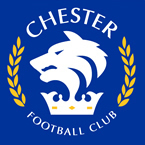|
Click on
the images for larger pictures.
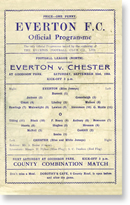 This summer a series of public
events will be held to commemorate the 60th anniversary
of the end of the
Second World War. The proceedings will be held across
the country culminating in National Commemoration Day
on Sunday July 10th. Separate ceremonies will also
be held to mark VE and VJ Days with the VE Day ceremony
taking place on May 8th and the VJ Day ceremony taking
place on Aug 21st. The Football League will also be
marking the occasion by looking at football’s
contribution during the war years. This summer a series of public
events will be held to commemorate the 60th anniversary
of the end of the
Second World War. The proceedings will be held across
the country culminating in National Commemoration Day
on Sunday July 10th. Separate ceremonies will also
be held to mark VE and VJ Days with the VE Day ceremony
taking place on May 8th and the VJ Day ceremony taking
place on Aug 21st. The Football League will also be
marking the occasion by looking at football’s
contribution during the war years.
When war broke out, in September 1939, Chester had
just started their ninth season in the Football League.
Two wins and a draw had put them in fourth place in
Division Three North but normal league football was
suspended following the declaration of war on September
3rd. In October a formal league of 12 clubs was organized
giving Chester the opportunity to compete against clubs
like Liverpool, Everton and the two Manchester clubs.
Chester finished ninth in the first Regional League
(Western Section).
Throughout the war years Chester continued to compete
against the bigger clubs from the area and achieved
some spectacular results. In many cases the team was
augmented by guest players who were stationed in the
area and unable to turn out for their own side. The
difficulties in raising a side also meant that many
local players were given an unexpected opportunity
to represent the club.
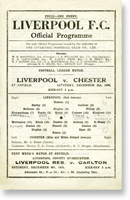 In the 1942/43 season Chester beat Manchester United
twice. The 4-1 victory in January was watched by only
1500 spectators at Sealand Road and included goals
from Jimmy McIntosh and Harold Iddon who were both
on the books at Preston. The other scorer was Leslie
Compton, the Arsenal full-back, who became the oldest
player to make his England debut in 1950 at the age
of 38. Compton represented Chester on a number of occasions
and even scored a hat-trick for the club when he played
at centre forward in a 5-4 victory against Everton
in February 1943. In the 1942/43 season Chester beat Manchester United
twice. The 4-1 victory in January was watched by only
1500 spectators at Sealand Road and included goals
from Jimmy McIntosh and Harold Iddon who were both
on the books at Preston. The other scorer was Leslie
Compton, the Arsenal full-back, who became the oldest
player to make his England debut in 1950 at the age
of 38. Compton represented Chester on a number of occasions
and even scored a hat-trick for the club when he played
at centre forward in a 5-4 victory against Everton
in February 1943.
Many of the wartime games were
high scoring and there could often be a huge turnaround
in results over a
few days. In the 1943/44 season Chester beat Liverpool
3-1 with two goals from West Bromwich’s Robin
Newsome but sent a weakened team to Anfield the following
week and were hammered 9-0. In the same season they
also lost 3-1 to Manchester United and then beat them
5-4 a mere seven days later. Other high scoring game
that season included an amazing 9-5 victory over Crewe,
a 9-2 home defeat to Everton and an 8-4 reverse at
Wrexham.
In December 1944 Chester hammered Manchester City
7-1 with a Scottish forward line including Armstrong
(Aberdeen) and the Hearts pair Andy Black and Bobby
Hamilton. Black, a Scotland international, was one
of the stars of the 1944/45 season and Chester unsuccessfully
tried to sign the popular forward after the war.
Another famous name to appear in blue and white was
Ellesmere Port born Joe Mercer who had played more
than 150 times for Everton before the war winning five
England caps. When league football resumed he played
for Arsenal and later famously managed Aston Villa,
Manchester City and England. One of the all-time great
centre forwards also played for Chester. Tommy Lawton
of Everton and England played in a friendly against
the RAF and scored 5 goals in an 11-4 victory.
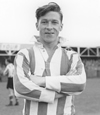 Two
of Chester’s most noted players also made
their full debuts during the war. Local boys Tommy
Astbury (left) and Dick Yates both featured in the
opening wartime fixture against Liverpool. Queensferry
born
Yates still holds the City record for most goals in
a Football League season with 36 in 1946/47. Astbury,
arguably one of Chester’s greatest players, went
on to play more than 300 times for the club in peacetime
football and was awarded two Welsh international caps
against England in 1945. He also guested for Manchester
United in the League North Cup Final of 1945 when he
finished on the losing side. Two
of Chester’s most noted players also made
their full debuts during the war. Local boys Tommy
Astbury (left) and Dick Yates both featured in the
opening wartime fixture against Liverpool. Queensferry
born
Yates still holds the City record for most goals in
a Football League season with 36 in 1946/47. Astbury,
arguably one of Chester’s greatest players, went
on to play more than 300 times for the club in peacetime
football and was awarded two Welsh international caps
against England in 1945. He also guested for Manchester
United in the League North Cup Final of 1945 when he
finished on the losing side.
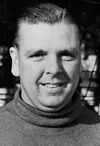 Another
future Welsh international, goalkeeper Bill
Shortt, also launched his football career with Chester
during the war years. Shortt (right), who died last
year, made more than 100 wartime appearances at Sealand
Road but joined Plymouth Argyle for £1000 in January
1946 and went on to play 12 times for Wales. Local youngster
Dave McNeil was a regular at left back during the war
and went on to play more than 100 times for the club
when hostilities ceased. Other players were not so lucky
however. Half-back Reg Dutton appeared frequently in
the side but never played a peacetime league fixture
while Ellesmere Port born Derek Williams played nearly
100 times at centre half but only featured twice in
Division Three North. Another
future Welsh international, goalkeeper Bill
Shortt, also launched his football career with Chester
during the war years. Shortt (right), who died last
year, made more than 100 wartime appearances at Sealand
Road but joined Plymouth Argyle for £1000 in January
1946 and went on to play 12 times for Wales. Local youngster
Dave McNeil was a regular at left back during the war
and went on to play more than 100 times for the club
when hostilities ceased. Other players were not so lucky
however. Half-back Reg Dutton appeared frequently in
the side but never played a peacetime league fixture
while Ellesmere Port born Derek Williams played nearly
100 times at centre half but only featured twice in
Division Three North.
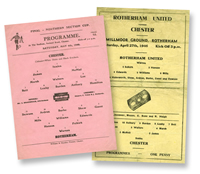 In the interim season, before the return to regular
football, Chester featured in the two legged final
of the Third Division North Cup Final against Rotherham
United. After a 2-2 draw at Millmoor more than 12,000
spectators turned up at the Stadium to see if Chester
could lift the cup but they left disappointed as the
Millers secured an aggregate 5-4 win. In the interim season, before the return to regular
football, Chester featured in the two legged final
of the Third Division North Cup Final against Rotherham
United. After a 2-2 draw at Millmoor more than 12,000
spectators turned up at the Stadium to see if Chester
could lift the cup but they left disappointed as the
Millers secured an aggregate 5-4 win.
The continuation of football during the war helped
improve the morale of the British public as they struggled
to come to terms with the horrors of the conflict.
Like many clubs Chester had to overcome transport difficulties
and problems in raising a side but a journey down Sealand
Road provided a welcome distraction from the hostilities.
With goals aplenty, First Division opposition and the
chance to see unfamiliar names in a blue and white
shirt Cestrians could at least take their minds off
the war for 90 minutes a week.
Chas
Sumner [Published 30/4/05]
|
